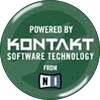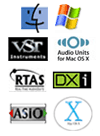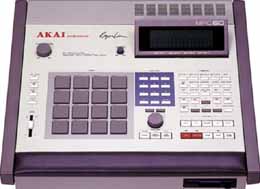|
Nostalgia demo 1
Nostalgia demo 2


|
 |
Roger Linn pretty much single-handedly
established the concept of the digital drum machine with his pioneering
and innovative LM-1 and LM-2 'Linndrum' in the early '80s and these
two drum machines pretty much defined the rhythmic backdrop of the
music of that era.
That achievement alone would have been enough to secure
Linn's position in modern music technology history but he had other,
more ambitious plans. He had a vision of user sampling and of multi-track,
multi-channel sequencing... a much greater vision of what defined
a drum machine. And so the Linn 9000 was born.
A highly adventurous project, Roger (inadvertently) pioneered
yet another concept that we take for granted today - the 'workstation'
where sampling, pattern creation and multi-channel sequencing are
all handled in one convenient table-top unit. |
| In 1984, it was a truly ground-breaking piece of modern
equipment - with 18 assignable, velocity sensitive pads it came
with 8-bit drum and percussion samples on EPROM but with the sampling
option installed, you could sample your own sounds and you could
sequence these with Linn's legendary real-time groovy 'shuffle'
quantise using the on-board 32-track sequencer. Linn saw no distinction
between drum patterns and the sequencing of external MIDI sound
sources and so it was possible (for the first time) to add musical
phrases to the drum patterns and subject them to the same groovy
quantise of the drum patterns - these rhythmic and musical passages
(sequences) could then be chained to create songs allowing complex
compositions to be realised from within one box. At the time, this
was totally revolutionary and once again proved that Roger Linn
was not only at the cutting edge of technology but was also providing
what users wanted (at the time) - a self-contained, stand-alone
drum machine/sequencer combination.
The Linn 9000 also had other innovations. For example, the hi-hat
decay slider that allowed you to switch between closed and open
hi-hats in real-time and the 'note repeat' function. There was also
a floppy disk drive for storing sequences and samples. On the rear
panel, the 9000 had extensive sync facilities (including a SMPTE
option and a tape sync facility) and multiple audio outputs... this
truly was a 'dream machine'!
It was also a dream machine for those who had paid the $5,000 asking
price for it - they would dream that one day the damned thing would
work!
Despite the fabulous possibilities it offered, the 9000 had more
bugs in it than a condemned roach-infected tenement block and if
you got through a day without it crashing, you were lucky! As you
can imagine, this caused a lot of frustration for the owners who,
by definition, were hi-end users often working in expensive studios.
Linn endeavoured to fix the bugs but in 1986, the company folded
with just 1,000 units having been produced.
However, the Linn 9000 story doesn't end there. |
Following the demise of Linn the company,
Linn the engineer/designer was invited to team up with the new kids
on the hi-tech block, Akai Professional, and in collaboration with
them, they developed the now legendary MPC60. This combined all
the benefits of the original Linn 9000 in a sturdy, ergonomically
designed case.
The MPC60 also brought new additions to the concept. The 9000's
small 2 x 16 LCD was replaced by a tiltable 240 x 60 LCD, the number
of sequencer tracks was expanded to 99 and sequencer memory was
expanded to cope with more data. The pads had aftertouch as well
as velocity sensitivity and the transport section was expanded to
include a locator. Also, features that were options on the 9000
(such as sampling, SMPTE, etc.) were standard on the MPC60. MIDI
connectivity was also improved to make the MPC the central focal
point of any MIDI production environment. |

Photo courtesy
of Akai Professional |
And all this came in at around the same price (or slightly
less) than the original 9000.
However, as well as inheriting everything that made the Linn 9000
such a desirable piece of equipment, the MPC60 V1.00 unfortunately
inherited many of the bugs and software problems that plagued the
original Linn 9000. When the MPC60 was released in 1988, it was
being bought in droves by top producers and artists of the time
(Trevor Horn and Peter Gabriel to name but two) and Akai's tech
support lines were inundated with calls from frantic (and often
famous!) users who had just lost a morning's work to some fatal
crash! This (understandably) gave the MPC60 a terrible reputation
on the streets but people stuck with it because it was unique -
the combination of user sampling with tight and 'groovy' multi-track
sequencing and extensive MIDI, sync and audio connectivity was just
too tempting to ignore. That the MPC60 was also incredibly easy
to use was another factor in keeping even the most frustrated owners
loyal to the cause!
Of course, the bugs were all ironed out in subsequent OS updates
and the MPC60 went on to become a legend. The MPC's unique 'feel'
was a big part of its success and it found favour in the emerging
rap/dance music market of the time. Many hit records in any number
of styles were made almost exclusively on an MPC60.
Today, of course, the MPC-series has moved on and we have the top-of-the-range
MPC4000 that takes the concept to the next level and we have the
'budget' MPC1000 that is, perhaps, a bit more loyal to its roots
but, either way, the basic philosophy of the Linn 9000 lives on
in all of these products. Even those who use modern computer based
sequencers and DAWs still prefer to use an MPC of one flavour or
another to lay down their beats.
|
|

